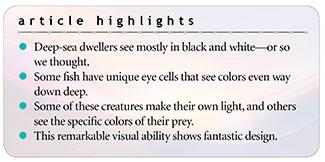 Only sunlight’s most intense color (blue) penetrates beyond 180 meters (590 feet) through clear ocean waters. Everyone knows that fish below such depths see an essentially black-and-white world. Only everyone is now wrong. New genetic insights provide a renewed appreciation of the Creator’s ingenuity.
Only sunlight’s most intense color (blue) penetrates beyond 180 meters (590 feet) through clear ocean waters. Everyone knows that fish below such depths see an essentially black-and-white world. Only everyone is now wrong. New genetic insights provide a renewed appreciation of the Creator’s ingenuity.
Deep-sea fish eyes come loaded with light-sensitive rod cells instead of the mixture of rods and color-sensitive cone cells surface-dwellers like us use. Our cone cells have three different pigments to detect the three primary colors. For humans and many vertebrates, various color intensities combine to generate the thousands of specific colors our visual systems perceive.
Our rod cells have only one pigment. These cells detect brightness in dim conditions but not colors, which means that in the dark our world is monochrome. Surely fish eyes without cone cells would see no colors. But research published in the journal Science found that some deep-sea fish eyes use various pigments…in their rod cells.1
Clearly, these fish swim in a deep, dark, but somehow colorful world. But why?
The researchers found rod cell pigment genes in 13 of the 101 fishes tested so far. Are they just evolutionary missteps—nature’s blind experiments that accidentally acted on actinopterygians (ray-finned fish)? Or do these genes serve a specific purpose through the intent of insightful intelligence?
The research seems to support the second option. University of Maryland biology professor Karen Carleton said in a university news release on the study, “It may be that their vision is highly tuned to the different colors of light emitted from the different species they prey on.”2
But these creatures’ equipment goes beyond special rod cells. All kinds of different sea creatures bioluminesce, or make their own light.3 This neat trick requires a very precise lineup of biochemicals to convert chemical currency into radiation. Human inventors long to match its efficiency. Of course, none of it would work without a specialized layer of clear skin cells to protect the underlying light-emitters while letting the light out.
More than that, bioluminescent creatures of all kinds—jellyfish, squid, clams, shrimp, fish, etc.—use precise biochemicals to emit specific colors. And now it looks like these newly discovered fish-eye rod cell pigments help the creatures see exactly the emitted color or colors of the prey they target. One fantastic fish called the silver spinyfin has 38 specific rod cell pigment genes. Can it see 38 specific deep-sea creatures’ colors?
The university news release said, “The specific wavelength of light their opsins [light-sensitive proteins] are tuned to overlap with the spectrum of light emitted by the bioluminescent creatures that share their habitat.”2
So, these eyes come fully tuned. Tuning requires a tuner. Whoever sees evolutionary accidents here may be dimming their own access to a broader spectrum of God’s fine-tuning in creation.
References
- Musilova, Z. et al. 2019. Vision using multiple distinct rod opsins in deep-sea fishes. Science. 364 (6440): 588-592.
- For Some Fish Deep and Dark May Still be Colorful. University of Maryland news release. Posted on umdrightnow.umd.edu May 10, 2019, accessed May 10, 2019.
- Thomas, B. 2013. The Unpredictable Pattern of Bioluminescence. Acts & Facts. 42 (4): 17.
* Dr. Thomas is Research Associate at the Institute for Creation Research and earned his Ph.D. in paleobiochemistry from the University of Liverpool.








